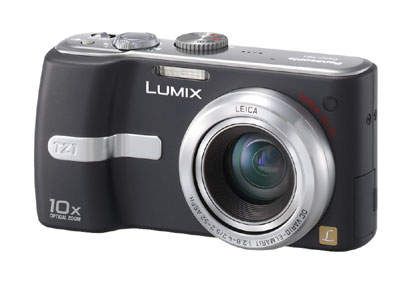Panasonic says the TZ1 is a “Travelers Treasure”, but it looks, well, a little less like a gem and is a bit on the clunky side. It’s not that small for a compact and it’s not that stylish either. It’s just a bit boring to look at. However, that relative blandness disguises a camera that not only boasts a world first in optical zoom capabilities but also hides a host of very neat features.
Our quick take
If you’re the type of snapper that requires a neat, well-specified digital camera with plenty of auto control and you will likely print no larger than, say, 5 x 7-inch prints then the TZ1 is a cert to include on your wish list. But…
This unique well-made, easy to use and well-specified compact is one that’s let the side down badly at the final analysis by image noise and noise reduction processing that removes vital detail.

Panasonic Lumix DMC TZ1 digital camera - 4.0 / 5
| FOR | AGAINST |
|---|---|
|
|
The first feature of note in the TZ1 is its excellent Leica, DC Vario-Elmarit F/2.8 – F/5, 35-350mm zoom lens that backs away into the body, neatly retracting into the camera’s carcass - the large zoom ratio has been achieved using an innovative retractable lens design, employing a prism, folded optics and three aspherical lens elements.
This lens focuses light onto a 5-megapixel CCD; while the resolution might seem a little low for today’s latest models, you’ll still get prints up to and over A4 in size but with a caveat on image noise that I’ll go into in detail a later.
Handling wise, the camera sits in the hand nicely and while it is compact for a 10x zoom model, it’s not very pocketable. The all-metal sculpted body is comfortable to hold and one handed operation is easily achievable thanks to the combination of camera size and MEGA Optical Image Stabilisation (OIS) that helps reduce camera shake at the longer focal lengths or in low lighting.
In terms of specification, the TZ1 offers plenty of kit that includes an extremely responsive nine-zone, linear AF set up, which works a treat. Panasonic’s new Venus III image processing engine is in there and helps trundle through the image data ensuring colour and noise is properly dealt with, then helping to shuffle it off to the storage being used (incidentally, you also get a modicum of 16MB internal storage).
And there are no less than 18-scene modes that include the ubiquitous: portrait, landscape/scenery and sports modes; alongside the less ubiquitous: food and aerial photo modes, the latter designed to help get snaps through aircraft windows. Movie recording is well catered to with (up to) 848 x 480 (widescreen) movies at up to 30fps to the limit of the storage in use.
So the kit, handling and responsiveness leave nothing to worry about, providing an extremely fast little camera, even the battery life is exemplary, a full charge lasting me around five days use; around 200 pictures with plenty of flash use a reviewing of images: there’s no optical viewfinder on the TZ1, so power usage is a key factor here.
The proof of the pudding is in the eating, however, in this case, it’s the image quality. And while the resolution is ample for most uses, colour is excellent, metering and white balance control is also good with a fast WB custom setting control. And now we reach that caveat I mentioned at the start of the test. Image noise.
The Venus III processor is obviously very hard at work in the TZ1 on almost every shot because noise is evident even at the lowest ISO 80 settings, particularly within shadow areas. The higher the ISO is set (you get 80, 100, 200, 400, 800 and 1600 boosted ISO settings) the harder the noise reduction works and the more detail is smoothed out of the shots as a result.
Over ISO 200, noise is obvious and over ISO 400, you’ll not be able to print larger than 6 x 4-inch prints without the noise artifacts being very obvious. So on one hand you have great performance but on the other noise reduction and noise undo the good work.
To recap
Great specification and excellent handling is marred by OTT image noise. Nevertheless, it’s an interesting and temptingly specified camera
